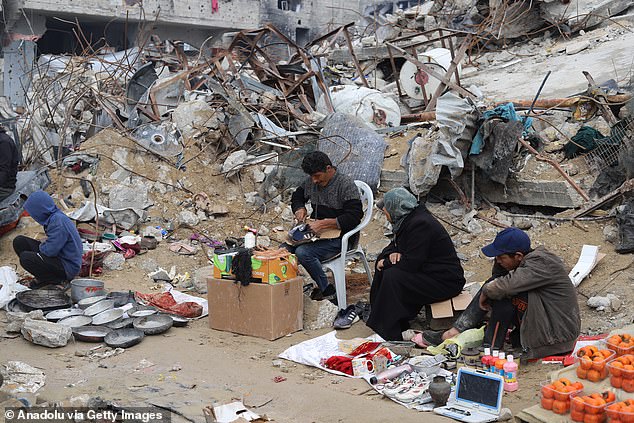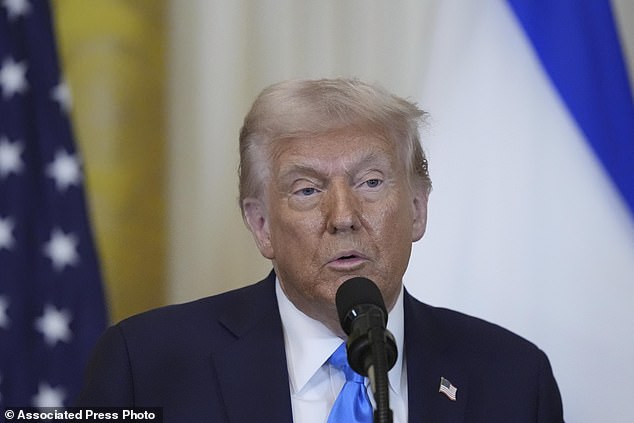Donald Trump elevated his brand of divisive, swashbuckling rhetoric to new heights earlier this week when he declared the United States could ‘take over the Gaza Strip… and own it’ following the ceasefire deal between Israel and Hamas.
The outlandish statement, in which the US President said he could rebuild Gaza to make it the ‘Riviera of the Middle East’ while resettling close to 2 million Palestinians in Jordan and Egypt, sparked a torrent of condemnation from the global community.
A spokesperson for the United Nations labelled the notion ‘tantamount to ethnic cleansing’, while leaders of the Arab world decried it as a blatant violation of international law.
What’s more, a US-led takeover of Gaza would seemingly betray an integral part of Trump’s campaign promise and his ‘America First’ rhetoric – namely, to scale down America’s military and political involvement in the Middle East.
But what politicians say and what politicians mean are often two different things.
What appears at first to be nothing more than an inflammatory harebrained scheme at best could conceal a more calculated strategy.
Dissecting Trump’s comments within the broader context of his presidency so far, along with the messaging from his advisers and conservative think tanks, reveals a few approaches the so-called ‘leader of the free world’ may have in mind.
On one end of the scale, experts suggest Trump’s bold proposal may be aimed at pressuring regional parties into taking responsibility for Gaza’s future governance and funding its reconstruction.
At the other end of the scale, some have posited that the US could seek to make Gaza a protectorate, preventing Israel from occupying the land and providing an ‘interim solution to pave the way for self-governance’.
And then, there are those who believe Trump is quite simply setting out to fundamentally reshape international norms, with the US set to profit.



In the same way that Trump has leveraged the threat of tariffs to bully Canada and Mexico into making pledges to beef up border security and crack down on drug trafficking, his proposal to take over Gaza could be a harsh negotiation tactic.
Dr Andreas Krieg, a leading expert on the Middle East and Senior Lecturer at King’s College London’s School of Security Studies, told MailOnline that Trump is likely trying to ‘squeeze concessions from and twist the arms of regional powers’ – a move described by critics as ‘geopolitical blackmail’.
Egypt, Jordan and Saudi Arabia are among the states who have roundly condemned Israel’s brutal war in Gaza and advocated for a two-state solution – but their support of the Palestinian plight has not extended beyond political grandstanding.
After the conflict erupted following Hamas’ October 7, 2023 attacks on Israel, each nation was quick to refuse any suggestion that they absorb large numbers of displaced Palestinians and have remained quiet about the prospect of rebuilding Gaza.
By floating an idea as extreme as a US takeover of the territory, Trump may be attempting to force those claiming to support Palestine to intervene and prevent such a wild notion from manifesting.
‘He’s trying to make (Arab partners) come to the negotiation table and say, ‘Okay, we’re going to sort this out, we’re going to pay for reconstruction, we’ll take charge when it comes to rebuilding a governance, a structure authority’,’ Krieg said.
‘The Gulf states should come up and say, ‘Look, anything is better than having the Americans go there, and then ethnically cleanse the territory’.
‘It’s the same way he’s doing it with Canada, with Mexico as well. It’s up to them to come up with a plan C. He’s throwing an absurd demand out there that freaks everyone else out. (Trump wants) them to say ‘Okay, let’s try to find a solution that’s somewhere in the middle.’


Former Israeli intelligence officer and regional analyst Avi Melamed agreed with Krieg’s position.
‘Trump’s statement is possibly part of what’s now emerging as his modus operandi – making tough and blunt statements and taking harsh positions to force his adversaries to break from their entrenched positions.
‘In many ways that strategy has worked for him closer to home and it will be interesting and refreshing to see how this may impact the ongoing negotiations between Israel and Hamas.,’ he concluded.
Should Trump be prepared to follow through on his proposal, however, the White House could seek to turn Gaza into a protectorate.
This tack would see Washington take the lead on reconstruction while working with regional powers and Palestinian politicians to hash out a future system of governance – an issue Krieg sees as one of the largest for post-war Palestine.
He reasoned that the US coming in would present an arguably better solution than the prospects currently on the table – an Israeli occupation of Gaza to ‘fill the void’ in the absence of a reasonable plan set forth by Arab leaders and the Gulf states, or Hamas ruling over the rubble.
Krieg was, however, very quick to point out that such an effort would be a huge undertaking for Washington and present a range of complex logisitical, operational and legal problems – not least the fact that Hamas still roams the Strip.
‘A third party coming in that is more neutral than the Israelis is better than chaos, and better than the Israelis taking over and occupying and remaining in the Gaza Strip for an indefinite period of time,’ he said. ‘This could pave the way for eventual self-governance in Gaza.
‘But there are all kinds of roadblocks… Hamas has obviously been degraded, but there are still around 15 to 20,000 people who are armed fighters for Hamas in the territory.
‘They will not allow for, you know, for the (mass displacement) of Palestinians. And they will also probably resist this becoming a protectorate.
‘Also logistically, one and a half million people cannot move into the Sinai desert, let alone going to Jordan – that’s just not feasible. It’s logistically not feasible. And Palestinians will refuse to leave.’
Krieg ultimately summed up his thoughts with a simple conclusion.
‘It’s very messy. And I can’t see why Trump would want to own this mess.’
Trump may not actually aim to own the mess that is post-war Gaza, though – at least not in the literal sense of the word.
In the hours following Trump’s proposal – delivered alongside beaming Israeli Prime Minister Benjamin Netanyahu – administration officials sought to clarify the finer points of his plan and assuage concerns the American taxpayer may be forced to fund it.




‘It was not meant as a hostile move. It was meant I think as a very generous move, the offer to rebuild and be in charge of the rebuilding of a place,’ Secretary of State Marco Rubio said.
‘What he very generously has offered is the ability of the United States to go in and help with debris removal, help with munitions removal, help with reconstruction – the rebuilding of homes and businesses and things of this nature, so that then people can move back in.’
Meanwhile, White House Press Secretary Karoline Leavitt added that Washington ‘would not pay’ for Gaza’s reconstruction and would instead ‘work with partners in the region’ – what Trump has referred to as ‘neighbouring countries with great wealth’.
Jonathan Panikoff, director of the Atlantic Council’s Scowcroft Middle East Security Initiative and former national intelligence officer, suggested that such an intervention would make ‘strategic sense’ for the US and ultimately contributes to Trump’s long-term vision of pulling back from the Middle East.
Writing in the ‘New Atlanticist’, Panikoff said: ‘From his perspective, the only way to reduce long-term US financial obligations in the Middle East, which are largely tied up in security support, is to gut Gaza and start over from the ground up.
‘If the United States doesn’t take the lead in doing that, then the long-term costs associated with having to protect Israel, for example, will continue indefinitely…
‘A US “take over” of Gaza must appear to be the best way to incubate a region of peace, eventually allowing security costs to be significantly reduced.’
Still, problems persist beyond the logistical, operational and legal challenges laid out by Krieg.
Trump is yet to have proper consultations with any regional powers regarding his plan – not even Israel.
Trying to force these states into bending to the US’ will over such a complex and highly charged issue could prove disastrous for America’s relations with its partners in an extremely important region – not to mention disapproving allies in the West.
Irrespective of what Trump’s ultimate goal may be, the experts seemed to agree on at least one thing.
World leaders can not afford to dismiss his proposal out of hand, lest they find themselves caught out by a man whose second term in the White House looks set to be yet more bold and explosive than the first.
